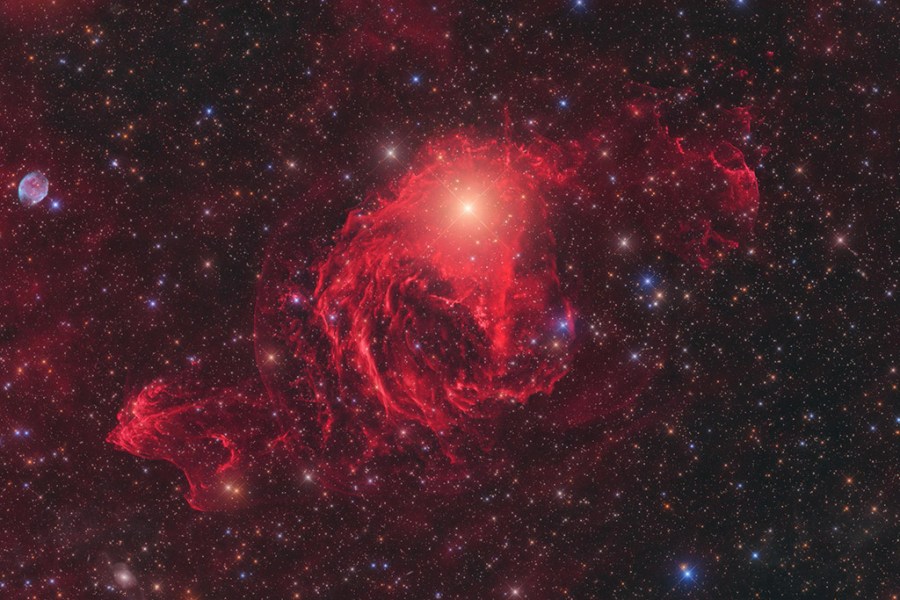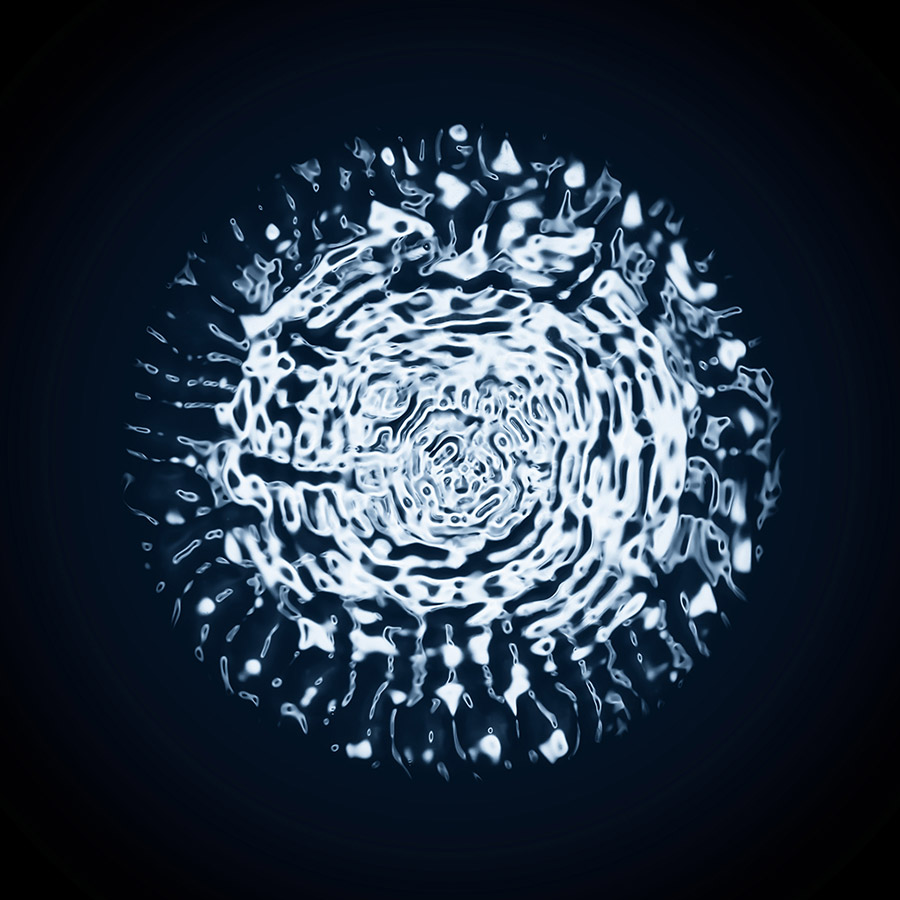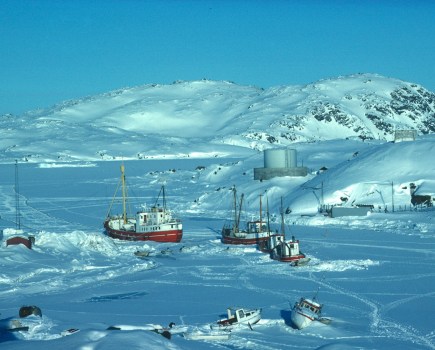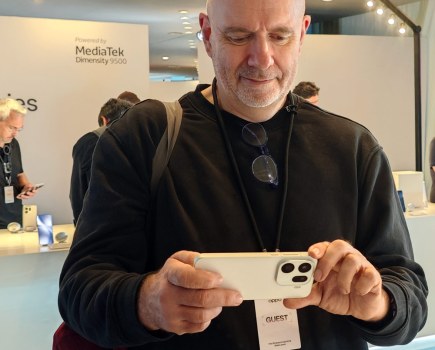Night photography and capturing space and our night skies is one of the most challenging but also impressive subjects in photography. The winners in Royal Observatory Greenwich’s Astronomy Photographer of the Year 15 competition are fantastic examples bringing the wider universe closer to home.
From over 4,000 entries from 64 countries, Marcel Drechsler, Xavier Strottner and Yann Sainty have been named as this year’s winners for their collaborative photograph Andromeda, Unexpected, showing a huge plasma arc next to the Andromeda Galaxy (M31). Likewise, the Young Astronomy Photographer of the Year category has been won collaboratively by Runwei Xu and Binyu Wang.
Winners will be on display at the National Maritime Museum from 16th September alongside a selection of shortlisted photos.
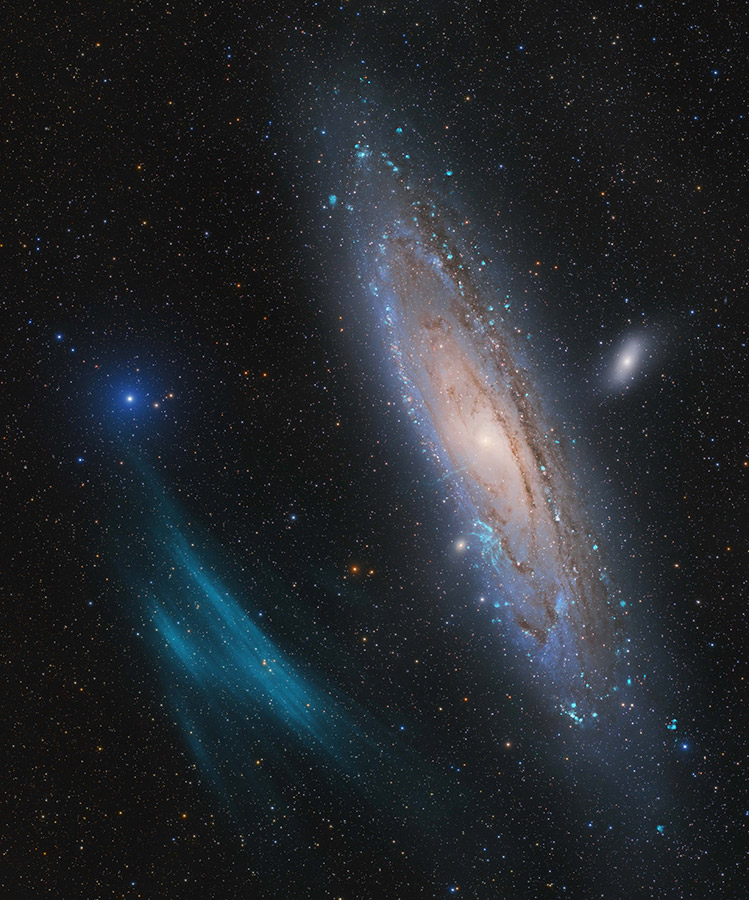
Andromeda, Unexpected © Marcel Drechsler, Xavier Strottner, Yann Sainty. Galaxies category winner and Overall Winner. Taken with a Takahashi FSQ-106EDX4 telescope, Sky-Watcher EQ6 Pro mount, ZWO ASI2600MM Pro camera, 382 mm f/3.6, multiple exposures between 1 and 600 seconds, 111 hours total exposure
From Royal Observatory Greenwich, 14 September 2023:
The overall winners of the Royal Observatory Greenwich’s Astronomy Photographer of the Year 15 are Marcel Drechsler, Xavier Strottner and Yann Sainty for their photograph Andromeda, Unexpected that captures a surprising discovery – a huge plasma arc next to the Andromeda Galaxy (M31). Scientists are now investigating the giant object in a transnational collaboration. It could be the largest such structure nearest to us in the Universe. The image will be on display alongside the winners of the other categories in the accompanying exhibition, opening at the National Maritime Museum on Saturday 16 September 2023.
The Andromeda Galaxy is the closest spiral galaxy to the Milky Way. It is undoubtedly one of the most photographed deep sky objects ever. The discovery of such a large structure in the immediate vicinity of the galaxy was all the more surprising. The arc has an extension of about 1.5 x 0.45 degrees, is only 1.2 degrees away from the centre of M31 and is located southeast of the main body of the galaxy.
Marcel Drechsler, Xavier Strottner and Yann Sainty said, ‘It’s an enormous honour for our team to receive this important award and we are grateful for all the support, friendship and encouragement we have received along our journey. It encourages us to continue to pursue our passion for astrophotography and, of course, research with dedication.’
László Francsics judge and astrophotographer said ‘This astrophoto is as spectacular as [it is] valuable. It not only presents Andromeda in a new way, but also raises the quality of astrophotography to a higher level.’
Young Astronomy Photographer of the Year
The Young Astronomy Photographer of the Year award was won by two fourteen-year-old boys from China. Runwei Xu and Binyu Wang collaborated to capture The Running Chicken Nebula, Yuri Beletsky, judge and professional astronomer described it as a ‘strikingly beautiful picture’.
Xu and Wang said, ‘Thank you to the Greenwich judges. We’re very glad to receive this achievement as winners of the Young Competition.’

The Running Chicken Nebula © Runwei Xu and Binyu Wang. Taken with an ASA N20 f/3.8 Newtonian telescope, ASA DDM85 mount, FLI Proline 16803 camera, 1,900 mm f/3.8, 5.5 hours total exposure
The other winning images include Circle of Light by Andreas Ettl, which shows the Northern Lights reflected on Skagsanden beach, Norway; The Dark Wolf – Fenrir by James Baguley, that shows a molecular cloud in the form of a wolf; A Sun Question by Eduardo Schaberger Poupeau, which captures a huge filament in the shape of a question mark; and Grand Cosmic Fireworks by Angel An, a photograph of the extremely rare phenomenon of atmospheric luminescence. In the Annie Maunder Prize for Image Innovation category, judges were impressed by John White’s Black Echo, which used audio source material from NASA’s Chandra Sonification Project, to visually capture the sound of the black hole at the centre of the Perseus Galaxy.
Another of the judges’ favourite images was New Class of Galactic Nebulae Around the Star YY Hya by Marcel Dreschsler that won the Stars and Nebulae category. The photograph captures a previously unknown galactic nebula containing a pair of stars surrounded by a common envelope, adding another exciting discovery to the winning images.
Dr Ed Bloomer, astronomer at Royal Observatory Greenwich said, ‘Once again, entrants to the Astronomy Photographer of the Year competition have conspired to make things difficult for the judges, with a flood of high-quality images covering an amazing range of targets. The highlight of this year is perhaps a number of genuine discoveries being imaged, but we’ve had wonderful efforts in every category and I’m particularly pleased to see the continued strength of our young entrants and those eligible for The Sir Patrick Moore Prize for Best Newcomer. It has led to some intense debate amongst the judges as we try to choose the very best of the best, but we don’t mind!’
Katherine Gazzard, Curator of Art at Royal Museums Greenwich said, ‘This was my first year as a judge for Astronomy Photographer of the Year. As a newcomer to the competition, the technical sophistication of the entries blew me away. So many beautiful images made the shortlist, and the winning images are absolutely stunning. It has made me look at the night sky in a new light.’
The Astronomy Photographer of the Year competition is run by Royal Observatory Greenwich, supported by Liberty Specialty Markets and in association with BBC Sky at Night Magazine. For the 2023 competition there were over 4,000 entries from 64 countries.
Astronomy Photographer of the Year 15: selection of category winners!
Stars & Nebulae – Winner
New Class of Galactic Nebulae Around the Star YY Hya by Marcel Drechsler
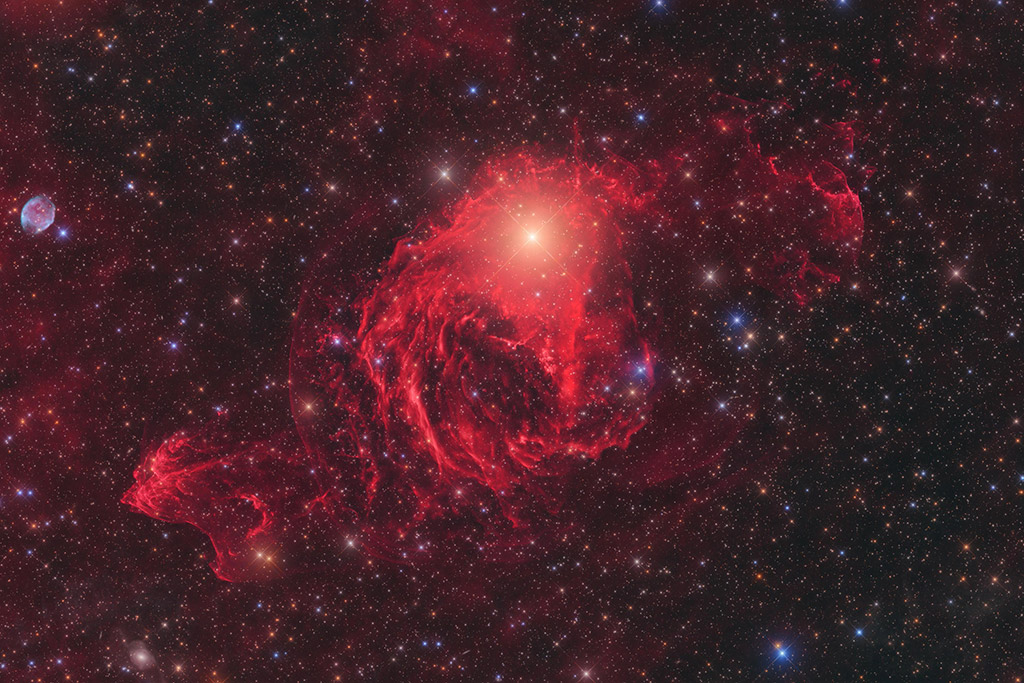
New Class of Galactic Nebulae Around the Star YY Hya © Marcel Drechsler. Taken with an ASA Newtonian 500 mm telescope, ASA DDM85 mount, FLI ProLine 16803 camera, 1,900 mm f/3.8, 890 x 1,200-second exposures, 672 x 300-second exposures and 15 x 1,800-second exposures
A team of amateur astronomers, led by Marcel Drechsler from Germany and Xavier Strottner from France, were able to make an important contribution to the study of the evolution of binary star systems: on old images of sky surveys, they discovered a previously unknown galactic nebula. At its centre, a pair of stars surrounded by a common envelope was found. On over 100 nights, more than 360 hours of exposure time were collected. The result shows an ultra-deep stellar remnant that the team has baptised ‘the heart of the Hydra’.
The Sir Patrick Moore Prize for Best Newcomer – Winner
Sh2-132: Blinded by the Light by Aaron Wilhelm

Sh2-132: Blinded by the Light © Aaron Wilhelm. Taken with a William Optics Fluorostar132 mm telescope, Chroma 3 nm/50 mm SII/H-alpha/OIII filters, Astro-Physics Mach2GTO mount, ZWO ASI6200MM Pro camera, 910 mm f/6.9, SII: 87 x 900-second exposures; H-alpha: 92 x 900-second exposures; OIII: 87 x 900-second exposures, 66 hours and 30 minutes total exposure
The Sh2-132 complex lies near the border of the Cepheus and Lacerta constellations and contains multiple deep sky structures. The photograph includes 70 hours of data, the rich interplay of all the gasses reveals something different each time you look at it.
Our Sun – Runner-up
Dark Star by Peter Ward
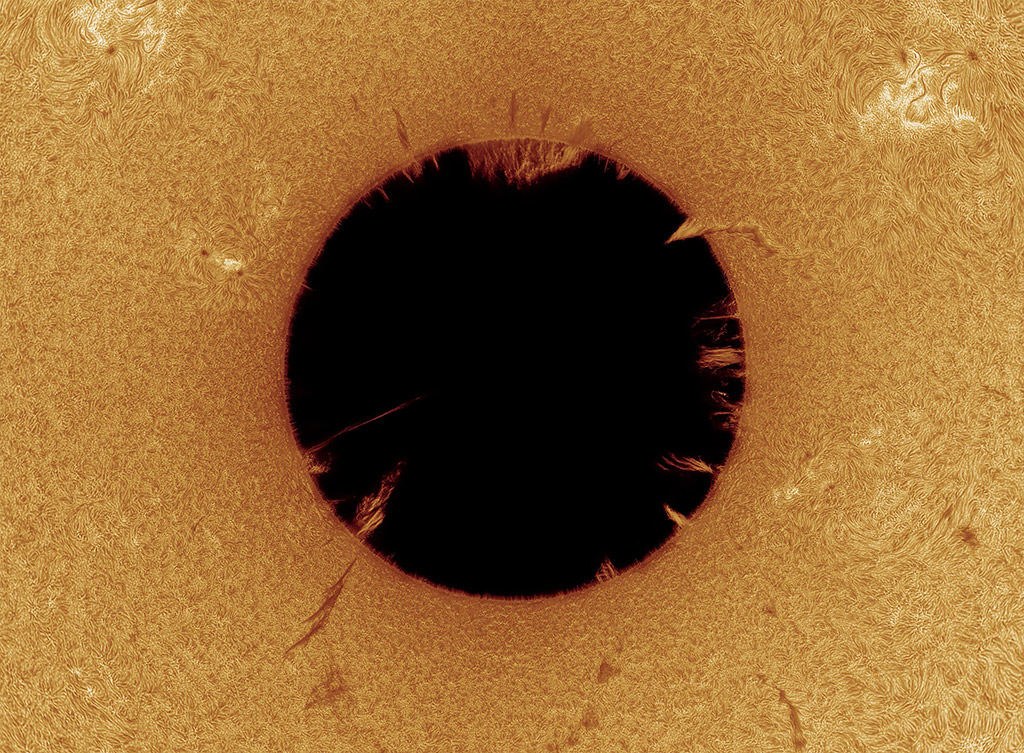
Dark Star © Peter Ward. Taken with an Astro-Physics 130GTX telescope, Coronado 90 mm lens, Paramount PMEII mount, QHY533M camera, 1,170 mm f/9, best 4% of 2,000 x 1/20-second exposures (4 seconds total exposure)
A photograph of the Sun turned ‘inside-out’. The photographer inverted the rectangular image onto polar coordinates to highlight the smaller prominences that occur on the edge of the Sun.
Annie Maunder Prize for Image Innovation – Winner
Black Echo by John White
Taking audio source material from NASA’s Chandra Sonification Project, White visually captured the sound of the black hole at the centre of the Perseus Galaxy.
The audio was played through a speaker onto which White attached a petri dish, blacked out at the bottom and then filled with about 3 mm of water. Using a macro lens and halo light in a dark room, White experimented with the audio and volumes to explore the various patterns made in the liquid.
Aurorae – Runner-up
Circle of Light by Andreas Ettl
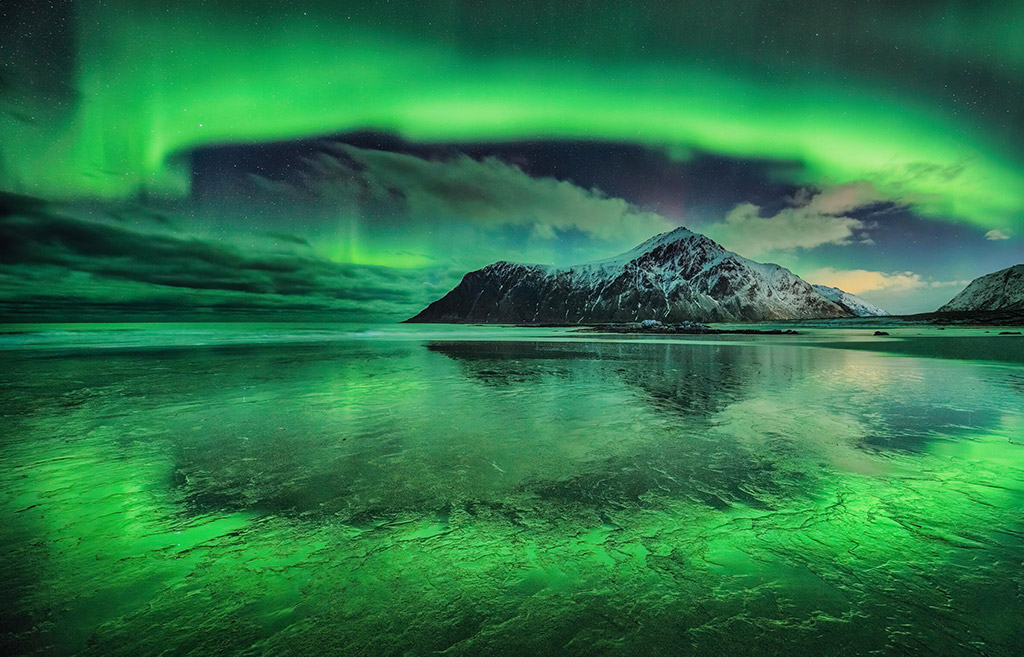
Circle of Light © Andreas Ettl. Taken with a Nikon Z7 camera, 15 mm f/2.8, ISO 1000, 8-second exposure
A vivid aurora over Skagsanden beach, Lofoten Islands, Norway. The mountain in the background is Hustinden, which the aurora appears to encircle.
People & Space – Highly Commended
Close Encounters of The Haslingden Kind by Katie McGuinness

Close Encounters of The Haslingden Kind © Katie McGuinness. Taken with a Sony ILCE-7M4 camera, 20 mm f/4, ISO 160; Sky: 151 x 25-second exposures; Foreground: 5-second exposure
Haslingden’s Halo is an 18-meter diameter sculpture located in the hills of Lancashire. McGuinness took inspiration from the Close Encounters of The Third Kind film poster to create her image. More than 150 images, taken over an hour and with exposures of 25 seconds each, were combined to show the apparent rotation of stars around Polaris.
Young Astronomy Photographer of the Year – Runner-up
Blue Spirit Drifting in the Clouds by Haocheng Li and Runwei Xu
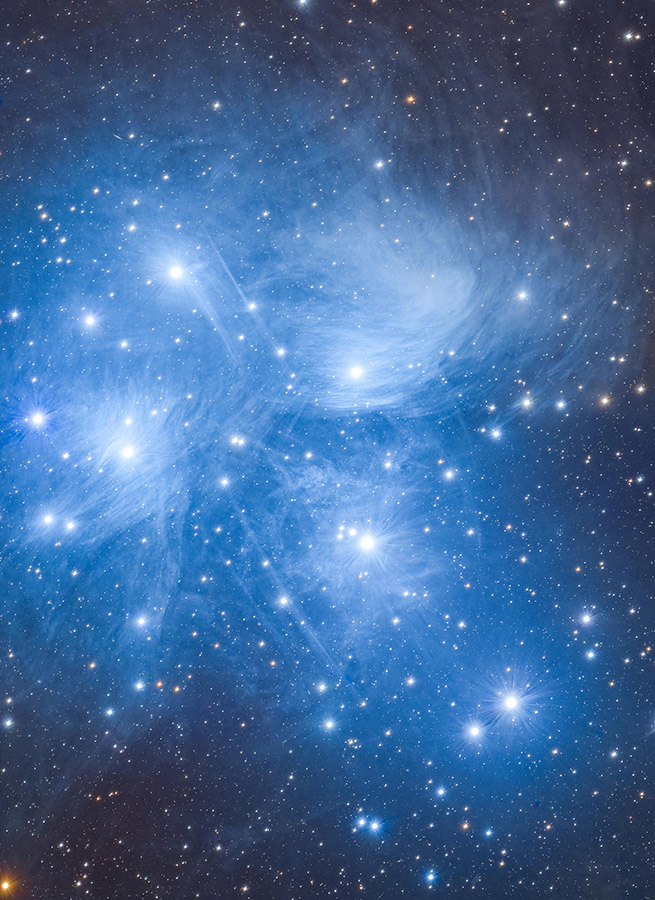
Blue Spirit Drifting in the Clouds © Haocheng Li and Runwei Xu. Taken with a Sky Rover 102APO telescope, Optolong LRGB filter, NEQ6 mount, ZWO ASI294MM camera, 714 mm f/7, ISO 100, multiple 300-second exposures, 9 hours total exposure
Pleiades is an open star cluster lit by the brightest stars, which illuminate the surrounding nebula giving it an attractive blue hue. The cluster is also known as the Seven Sisters, because many people can see seven stars. But as astrophotography reveals, there are actually over 1,000.
See more images from the Astronomy Photographer of the Year shortlist
Astronomy Photographer of the Year 15 Exhibition
The winning photographs will be exhibited at the National Maritime Museum alongside a selection of shortlisted images.
National Maritime Museum, London
Opening 16 September 2023
Tickets: £10
See our pick of the best photography competitions to enter and photography exhibitions to see.
More news:
Bird Photographer of the Year winners revealed
Weather Photographer of the Year 2023 shortlist announced
Minimalist Photography Awards 2023 winners announced
Creator of the Year competition
Follow AP on Facebook, Twitter, Instagram, YouTube and TikTok.

